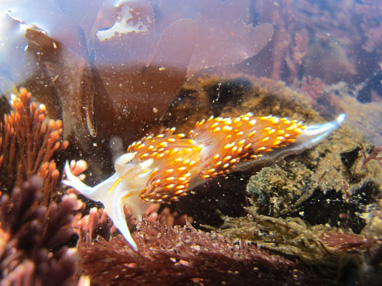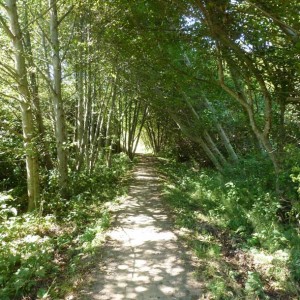Point Reyes Peninsula is rimmed along its rocky sections with a living fringe so diverse and wildly colorful – so dense with phenomenal creatures – that when the tides recede there’s a gravitational pull to go there and explore.
Tidepools are literally the wilderness next door, yet accessible only when the moon and sun conspire to exert extra pull on the Earth’s oceanic sheath, thereby exposing the coastline.
May through July is one of the two periods in the year when extreme low tides occur. These so-called “minus tides” happen near the full moon and cause the sea to dip to its lowest levels. For several days, two hours shortly after sunrise, you can visit the realm of marine algae and invertebrates (A series of minus tides also occur in the fall, but during darkness).
Sea slug delight
In early June, on a full moon just past perigee (which accentuates the tides), the tide dipped to minus 1.9 feet (meaning 1.9 feet below the mean . Acres of algae and invertebrates along reefs emerged from the ocean for a little while, a chance to hunt for the tidepooler’s great prize: bizarre and colorful nudibranchs, or sea slugs. The summer’s full crop of seaweeds, in every color and texture – many slippery – made locomotion comical for upright bipeds.

Most living things in the intertidal stay put, and for good reason – they live their lives in the constant motion of waves. Yet floating delicately in some of the surge channels are the soft and diminutive sea slugs. Seemingly vulnerable, they are seldom eaten except by one another. These little gastropods (snails) are carnivores that graze on gritty sponges and stinging hydrozoans, relatives of jellyfish. The beauty of sea slugs is phenomenal – surreal body appendages and brilliant colors.
Along with old friends Hermissenda (the opalescent nudibranch) and Diaulula (the spotted or leopard nudibranch), one of the six species here is Phidiana hiltoni, an aggressive predator nicknamed the “killer nudibranch” that’s been gradually spreading north from its formerly limited waters south of Monterey. Marine researchers say they first saw P. hiltoni near Bolinas in 1994, and it’s gotten as far as the Duxbury and Palomarin reefs near Bolinas at Point Reyes, wiping out other sea slugs as it expands, likely due to climate change. Keep an eye out for P. hiltoni at Point Reyes and northward.
Now’s the time to plan a tidepooling trip to Point Reyes. Late June into early July 2012 have a number of days when extreme minus tides occur during early daylight hours. Check out this tide chart to plan your trip, and this suggested list of tidepooling locations.





